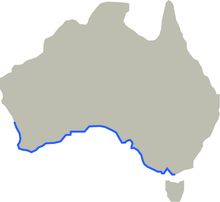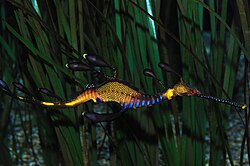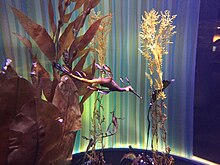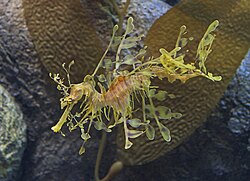I put in the definer "Sea Dragon" into my search engine at my site (there appear to be 2 search engines regarding my site here by the way. So, here is the result:
begin quote from:
Common seadragon - Wikipedia
HERE'S WHAT A COMMON SEADRAGON LOOKS LIKE THAT DOESN'T HAVE ALL THE APPENDAGES THAT LOOK LIKE KELP OR LEAVES:
BEGIN QUOTE FROM:
COMMON SEADRAGON - WIKIPEDIA
Common seadragon. Common seadragon or weedy seadragon (Phyllopteryx taeniolatus) is a marine fish related to the seahorse. Adult common seadragons are a reddish colour, with yellow and purple markings; they have small leaf-like appendages that resemble kelp fronds providing camouflage and a number of short spines for protection.-
Common seadragon
Common seadragon or weedy seadragon (Phyllopteryx taeniolatus) is a marine fish related to the seahorse. Adult common seadragons are a reddish colour, with yellow and purple markings; they have small leaf-like appendages that resemble kelp fronds providing camouflage and a number of short spines for protection.[2][3] Males have narrower bodies and are darker than females.[3]Seadragons have a long dorsal fin along the back and small pectoral fins on either side of the neck, which provide balance.[4] Common seadragons can reach 45 cm (18 in) in length.Common seadragon 
Phyllopteryx taeniolatus in Cabbage Tree Bay, Sydney, Australia Conservation status Scientific classification 
Kingdom: Animalia Phylum: Chordata Class: Actinopterygii Order: Syngnathiformes Family: Syngnathidae Genus: Phyllopteryx Species: P. taeniolatus Binomial name Phyllopteryx taeniolatus
(Lacepède, 1804)Phyllopteryx taeniolatus range
The common seadragon is the marine emblem of the Australian State of Victoria.[5]CONTENTS
RANGE
The common seadragon is endemic to Australian waters of the Eastern Indian Ocean and the South Western Pacific Ocean. It can be found approximately between Port Stephens (New South Wales) and Geraldton, Western Australia, as well as Tasmania.[6]
Common Seadragon, Phyllopteryx taeniolatus, from the Sketchbook of fishes by William Buelow Gould, 1832HABITAT
The common seadragon inhabits coastal waters down to at least 50 m (160 ft) deep. It is associated with rocky reefs, seaweed beds, seagrass meadows and structures colonised by seaweed.[7]BIOLOGY
These fish are slow-moving and rely on their camouflage as protection against predation; they drift in the water and with the leaf-like appendages resemble the swaying seaweed of their habitat.[3] They lack a prehensile tail that enables similar species to clasp and anchor themselves.
Individuals are observed either on their own or in pairs; feeding on tiny crustaceans and other zooplankton by sucking prey into their toothless mouths.[3] Like seahorses, seadragon males are the sex that cares for the developing eggs. Females lay around 120 eggs onto the brood patch located on the underside of the males' tail.[3] The eggs are fertilised and carried by the male for around a month before the hatchlings emerge.[3]
Seadragons, seahorses and pipefish are among the few known species where the male carries the eggs. The young are independent at birth, beginning to eat shortly after.[8] Common seadragons take about 28 months to reach sexual maturity, and may live for up to six years.[9]
Mating in captivity is relatively rare since researchers have yet to understand what biological or environmental factors trigger them to reproduce. The survival rate for young common seadragons is low in the wild, but it is about 60% in captivity.[10]Common Seadragon
The Aquarium of the Pacific in Long Beach, California and the Tennessee Aquarium in Chattanooga, Tennessee[11] in the USA, and the Melbourne Aquarium in Melbourne, Australia[12] are among the few facilities in the world to have successfully bred common seadragons in captivity, though others occasionally report egg laying.[13] In March 2012 the Georgia Aquarium in Atlanta, USA, announced a successful breeding event of common seadragons.[14] As of July 2012, the Monterey Bay Aquarium has also successfully bred and hatched out baby common seadragons on exhibit.[15]THREATS
The common seadragon is classified as Least Concern (LC) on the IUCN Red List 2006.[16] While the common seadragon is a desired species in the international aquarium trade, the volume of wild-caught individuals is small and therefore not currently a major threat. Instead, habitat loss and degradation due to human activities and pollution threaten common seadragons most.
The loss of suitable seagrass beds, coupled with natural history traits that make them poor dispersers, put the future of seadragon populations at risk. This species is not at present a victim of bycatch or a target of trade in Traditional Chinese Medicine, two activities which are currently a threat to many related seahorse and pipefish populations.[17][18]CONSERVATION
It is illegal to take or export these species in most of the states within which they occur.[3] A database of seadragon sightings, known as 'Dragon Search' has been established with support from the Marine and Coastal Community Network (MCCN), Threatened Species Network (TSN) and the Australian Marine Conservation Society (AMCS), which encourages divers to report sightings.[3] Monitoring of populations may provide indications of local water quality and seadragons could also become an important 'flagship' species for the often-overlooked richness of the unique flora and fauna of Australia’s south coast.[3]
Captive breeding programs are in place for the weedy seadragon, headed up by Sea Life Melbourne Aquarium. The dragon has been difficult to breed in captivity, though in 2015 research observing the creatures in the wild and trying to replicate the conditions in captivity had researchers making changes to the light, water temperature and water flow proving to be key.Weedy Seadragon
In December 2015 the Melbourne aquarium had eggs hatch and the aquarium's weedy seadragon population significantly increased, reporting in March 2016 that 45 fry were still going strong—an outcome which represents a 95 percent survival rate.[19]RELATED SPECIES
The common seadragon is in the subfamily Syngnathinae, which contains all pipefish. It is most closely related to the other member of its genus, the ruby seadragon (Phyllopteryx dewysea), and also the leafy seadragon (Phycodurus eques). Haliichthys taeniophorus, sometimes referred to as the "ribboned seadragon" is not closely related (it does not form a true monophyletic clade with weedy and leafy seadragons).[20]
The common seadragon was previously the only member of its genus until the description of the ruby seadragon in 2015.[21]ONGOING RESEARCH
In the November 2006 issue of National Geographic magazine, marine biologist Greg Rouse is reported as investigating the DNA variation of the two seadragon species across their ranges.REFERENCES
This article incorporates text from the ARKive fact-file "Common seadragon" under the Creative Commons Attribution-ShareAlike 3.0 Unported License and the GFDL. - Connolly, R. (2006). "Phyllopteryx taeniolatus". IUCN Red List of Threatened Species. IUCN. 2006: e.T17177A6801911. doi:10.2305/IUCN.UK.2006.RLTS.T17177A6801911.en.
-
- Bray, D.J. 2011, Common Seadragon, Phyllopteryx taeniolatus, in Fishes of Australia, accessed 26 Aug 2014, http://www.fishesofaustralia.net.au/home/species/3127
- "Rare Ruby Seadragon uncovered in Western Australia". Western Australian Museum. Retrieved 19 February2015.
EXTERNAL LINKS
| Wikimedia Commons has media related to Weedy seadragon. |
- Common seadragon media at ARKive

- Australian Museum Online - Leafy and Weedy Seadragons
- Leafy Seadragons and Weedy Seadragons
- Weedy Sea Dragon Monitoring Program in Botany Bay
- Leafy Sea Dragon Festival
- Weedy Sea Dragon
- Youtube Male Weedy Seadragon with eggs
- Youtube Weedy Seadragon
- Male Weedy Sea Dragon carrying eggs
- BBC Weedy seadragon videos, news and facts
I've seen one of these at Monterey Bay Aquarium in person
THEY LOOK LIKE MOVING PLANT LIFE. IT'S A GREAT DISGUISE FOR THIS CREATURE UNDERWATER. IT'S A VARIATION OF A SEA HORSE THAT LIVES IN THE WATERS OFF OF WOOL BAY, AUSTRALIA SO IT IS DEFINITELY A TROPICAL KIND OF CREATURE THERE.
A LEAFY SEADRAGON IN THE WATERS OFF WOOL BAY, AUSTRALIA
Australia’s southern coast is leafy seadragon territory, so it’s the place to go if you want to see the camouflaged critter in its native habitat. This amazing specimen was photographed near Wool Bay. The leafy seadragon has evolved to resemble seaweed as a way to fool predators. It’s a relative of the seahorse, but isn’t quite the swimmer that its cousin is, so the camouflage gives it a big advantage.
LEAFY SEADRAGON (PHYCODURUS EQUES) - ARKIVE
Leafy seadragon description. Leafy seadragons (Phycodurus eques) are exquisitely camouflaged fish. Belonging to the same family as seahorses and pipefish (Syngnathidae), they resemble these with their elongated snout and bony-plated body .BEGIN QUOTE FROM:
LEAFY SEADRAGON - WIKIPEDIA
https://en.wikipedia.org/wiki/Leafy_seadragonThe leafy seadragon or Glauert's seadragon, Phycodurus eques, is a marine fish in the family Syngnathidae, which includes seadragons, pipefish, and seahorses. It is the only member of the genus Phycodurus.- Description ·
- Habitat and distribution ·
- Ecology ·
- Conservation ·
- In captivity
-
The leafy seadragon or Glauert's seadragon, Phycodurus eques, is a marine fish in the family Syngnathidae, which includes seadragons, pipefish, and seahorses. It is the only member of the genus Phycodurus.Leafy seadragon 
Conservation status Scientific classification 
Kingdom: Animalia Phylum: Chordata Class: Actinopterygii Order: Syngnathiformes Family: Syngnathidae Subfamily: Syngnathinae Genus: Phycodurus
T. N. Gill, 1896Species: P. eques Binomial name Phycodurus eques
(Günther, 1865)
Phycodurus eques range Synonyms - Phycodurus glauertiWhitley, 1939
- Phyllopteryx equesGünther, 1865
It is found along the southern and western coasts of Australia. The name is derived from the appearance, with long leaf-like protrusions coming from all over the body. These protrusions are not used for propulsion; they serve only as camouflage. The leafy seadragon propels itself by means of a pectoral fin on the ridge of its neck and a dorsal fin on its back closer to the tail end. These small fins are almost completely transparent and difficult to see as they undulate minutely to move the creature sedately through the water, completing the illusion of floating seaweed.
Popularly known as "leafies", it is the marine emblem of the state of South Australia and a focus for local marine conservation.[2][3]CONTENTS
DESCRIPTION
Much like the seahorse, the leafy seadragon's name is derived from its resemblance to another creature (in this case, the mythical dragon). While not large, they are slightly larger than most seahorses, growing to about 20–24 cm (8–9.5 in). They feed on plankton and small crustaceans.
The lobes of skin that grow on the leafy seadragon provide camouflage, giving it the appearance of seaweed.[4] It is able to maintain the illusion when swimming, appearing to move through the water like a piece of floating seaweed. It can also change colour to blend in, but this ability depends on the seadragon's diet, age, location, and stress level.
The leafy seadragon is related to the pipefish and belongs to the family Syngnathidae, along with the seahorse. It differs from the seahorse in appearance, form of locomotion, and its inability to coil or grasp things with its tail. A related species is the weedy seadragon, which is multicoloured and grows weed-like fins, but is smaller than the leafy seadragon. Another unique feature are the small, circular gill openings covering tufted gills, very unlike the crescent-shaped gill openings and ridged gills of most fish species.[5]HABITAT AND DISTRIBUTION
The leafy seadragon is found only in southern Australian waters, from Wilson’s Promontory in Victoria at the eastern end of its range, westward to Jurien Bay, 220 km (140 mi) north of Perth in Western Australia.[1][6] Individuals were once thought to have very restricted ranges; but further research has discovered that seadragons actually travel several hundred metres from their habitual locations, returning to the same spot using a strong sense of direction. They are mostly found over sand patches in waters up to 50 m (160 ft) deep, around kelp-covered rocks and clumps of sea grass.[2] They are commonly sighted by scuba divers near Adelaide in South Australia, especially at Rapid Bay, Edithburgh, and Victor Harbor.[7][8]ECOLOGY
Leafy seadragons usually live a solitary lifestyle. When the time comes, males court the females, they then pair up to breed. From the moment they hatch, leafy seadragons are completely independent. By the age of two, they are typically full grown and ready to breed.[9]
The species feeds by sucking up small crustaceans, such as amphipods and mysid shrimp, plankton, and larval fish through its long, pipe-like snout.[2]Reproduction
As with seahorses, the male leafy seadragon cares for the eggs. The female produces up to 250 bright pink eggs, then deposits them onto the male's tail with her ovipositor, a long tube. The eggs then attach themselves to a brood patch, which supplies them with oxygen. After 9 weeks, the eggs begin to hatch, depending on water conditions. The eggs turn a ripe purple or orange over this period, after which the male pumps his tail until the young emerge, a process which takes place over 24–48 hours. The male aids in the eggs hatching by shaking his tail, and rubbing it against seaweed and rocks. Once born, the young seadragon is completely independent, eating small zooplankton until large enough to hunt mysids. Only about 5% of the eggs survive.[2]Movement
The leafy seadragon uses the fins along the side of its head to allow it to steer and turn. However, its outer skin is fairly rigid, limiting mobility. Individual leafy seadragons have been observed remaining in one location for extended periods of time (up to 68 hours), but will sometimes move for lengthy periods. The tracking of one individual indicated it moved at up to 150 m (490 ft) per hour.[10]CONSERVATION
Leafy seadragons are subject to many threats, both natural and man-made. They are caught by collectors, and used in alternative medicine. They are vulnerable when first born, and are slow swimmers, reducing their chance of escaping from a predator. Seadragons are often washed ashore after storms, as unlike their relative the seahorse, seadragons cannot curl their tails and hold onto seagrasses to stay safe.[11]
The species has become endangered through pollution and industrial runoff, as well as collection for the aquarium trade. In response to these dangers, the species has been totally protected in South Australia since 1987, Victoria since at least 1995, and Western Australia since 1991. Additionally, the species' listing in the Australian government's Environment Protection and Biodiversity Conservation Act 1999 means that the welfare of the species has to be considered as a part of any developmental project.[1][12][13]IN CAPTIVITY
Due to being protected by law, obtaining seadragons is often an expensive and difficult process as they must be from captive bred stock, and exporters must prove their broodstock were caught before collecting restrictions went into effect, or that they had a license to collect seadragons. Seadragons have a specific level of protection under federal fisheries legislation as well as in most Australian states where they occur.[1] Seadragons are difficult to maintain in aquaria. Success in keeping them has been largely confined to the public aquarium sector, due to funding and knowledge that would not be available to the average enthusiast. Attempts to breed the leafy seadragon in captivity have so far been unsuccessful.[14] Aside from the legalities, leafy seadragons cost between $10,000 and $15,000 a piece, prohibitive to most collectors.[citation needed]
Australia
Australian aquaria featuring leafy seadragons include the Sydney Aquarium,[15]the Melbourne Aquarium, and the Aquarium of Western Australia.[16]Canada
Ripley's Aquarium of Canada in Toronto displays both leafy and weedy seadragons.[17][18]
Leafy seadragon at the Monterey Bay AquariumUnited States
A number of aquaria in the United States have leafy seadragon research programs or displays. Among these are the Adventure Aquarium in Camden, New Jersey,[19] Aquarium of the Pacific at Long Beach,[20] the Birch Aquariumat Scripps, San Diego,[21] the Minnesota Zoo,[22] the Monterey Bay Aquarium[23] in California, the Dallas World Aquarium, Texas,[24] the New England Aquarium, Boston,[25] the Point Defiance Zoo & Aquarium in Tacoma, Washington,[26] the Shedd Aquarium, Chicago,[27] the California Academy of Sciences,[28] the Tennessee Aquarium,[29] Sea World Orlando, Florida[citation needed], the Pittsburgh Zoo & PPG Aquarium,[citation needed], Ripley's Aquarium of the Smokies, Gatlinburg, Tennessee[citation needed], and The Florida Aquarium in Tampa, Florida.[citation needed] and the Mote Aquarium in Sarasota, Florida.[citation needed], Ripley's Aquarium Broadway at the Beach, Myrtle Beach, South Carolina.[citation needed]CULTURAL REFERENCES
The leafy seadragon is the official marine emblem of the state of South Australia.[30] It also features in the logos of the following South Australian associations — the Adelaide University Scuba Club Inc. and the Marine Life Society of South Australia Inc.[31][32]
A biennial Leafy Sea Dragon Festival is held within the boundaries of the District Council of Yankalilla in South Australia. It is a festival of the environment, arts and culture of the Fleurieu Peninsula, with the theme of celebrating the leafy seadragon. The inaugural festival in 2005 attracted over 7,000 participants including 4000 visitors.[33]
In 2006, an animated short film, The Amazing Adventures of Gavin, a Leafy Seadragon, was made on behalf of several South Australian organisations involved in conserving the marine environment, including the Coast Protection Board, the Department of Environment and Heritage and the Marine Discovery Centre.[34][35][36] Made through a collaboration of The People's Republic of Animation, Waterline Productions and the SA Film Corporation,[37] the film is an introductory guide to marine conservation and the marine bioregions of South Australia suitable for 8-12 year olds,[38] and copies were distributed on DVD to all primary schools in the State. An educator's resource kit to accompany the film was released in 2008.[39][40]SEE ALSO
- Sea Dragon (disambiguation)
- Weedy seadragon (Common seadragon)
- Ruby seadragon
- Seahorse
- Pipefish
REFERENCES
- Pollom, R (2017). "Phycodurus eques". IUCN Red List of Threatened Species. IUCN. 2017: e.T17096A67622420. Retrieved 14 September 2017.
- "Press release 24/8/2008: Gavin goes to school". Department of Premier and Cabinet. 24 August 2008. Retrieved 17 August 2011.
FURTHER READING
- Connolly, R. M. (September 2002). "Patterns of movement and habitat use by leafy seadragons tracked ultrasonically". Journal of Fish Biology. 61 (3): 684–695. doi:10.1111/j.1095-8649.2002.tb00904.x.
EXTERNAL LINKS
| Wikimedia Commons has media related to Phycodurus eques. |
- Australian Museum > Leafy Seadragon Retrieved 8 August 2011.
- Marine Life Society of South Australia > Leafy Seadragon photos Retrieved 8 August 2011.
- Reef Watch > Dragon Search > Photo Library Retrieved 8 August 2011.
- Seadragon Foundation Inc > Leafy Seadragon Archived from the original webpage. Retrieved 17 February 2014.
- Underwater Australasia > Vanishing Dragon Article on making of a documentary film and DVD. Retrieved 8 August 2011.
- Leafy sea dragon documentary film "The Vanishing Dragon" Scuba diving in South Australia, Retrieved 9 January 2013.
- Aquarium of the Pacific > Online Learning Center > Leafy Seadragon Retrieved 8 August 2011.
- Leafy seadragon information
- FishBase > Phycodurus eques (Günther, 1865), Leafy seadragon Retrieved 17 August 2011.
- Fused Jaw > Keep a Watchful Eye on the Sea Dragons of Southern AustraliaRetrieved 8 August 2011.
- Jeffrey N. Jeffords, Dive Gallery > Leafy Sea Dragons Photo and multimedia gallery. Retrieved 8 August 2011.
- MarineBio Conservation Society > Phycodurus eques, Leafy Sea Dragons Retrieved 8 August 2011.
- Phycodurus eques - IUCN database entry includes a range map and a lengthy justification of why this species is Least Concerned.








No comments:
Post a Comment